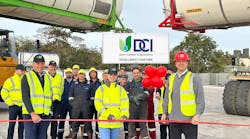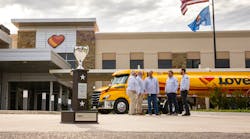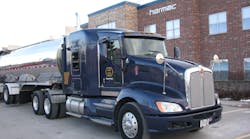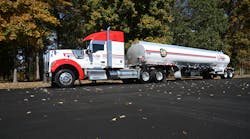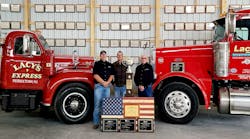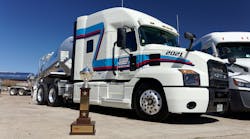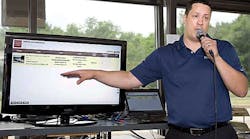TWO commercial trucks and a commercial motorcoach bus equipped with new mobile safety compliance technology demonstrated, for the first time on June 20, a significant step in improving highway safety.
In a drive-by demonstration at the West Friendship Weigh Station and Inspection Site in Maryland, on June 17, industry stakeholders observed trucks and buses electronically communicating with weigh station systems as they approached the facility, without ever having to slow down. Critical safety data on both vehicle and driver, including driver ID, electronic logging information, and the weight of the vehicle, were shown communicating in real-time while vehicles remained in motion—representing the first commercial application of its kind in the world.
Looking on were Administrator Anne Ferro from the Federal Motor Carrier Safety Administration (FMCSA), Administrator Victor Mendez from the Federal Highway Administration (FHWA), Stephen Keppler, executive director of the Commercial Vehicle Safety Alliance, Bill Graves, president and CEO of the American Trucking Associations, Thomas Kern, from the Intelligent Transportation Society of America, and other government officials.
“It’s next-generation technology, delivered today,” said Brian Heath, president of Burlingame CA-based Drivewyze Inc. “An ‘e-Inspection,’ as we call it, is the first commercial vehicle-to-infrastructure (V2I) solution for large trucks and buses to leverage GPS and telematics technologies to augment traditional roadside safety inspections. Along with our in-truck technology partners PeopleNet, XRS, and Zonar, we were proud to be supporting Maryland State Police and the trucking industry in demonstrating an innovative and cost-effective program to improve highway safety and efficiency.”
According to Captain Norman Dofflemyer, commander of the Maryland State Police Commercial Vehicle Enforcement Division, state weigh and inspection sites are the front line in reviewing a carrier and driver’s safety profile through Compliance, Safety, Accountability (CSA) scores. “If the carrier or driver has a solid safety record, and is not overweight (scales are at station sites), we can wave them through at the inspection site,” he said. “If we see a borderline case, or poor CSA score, we may inspect driver information and logbooks, plus do a vehicle inspection.”
Dofflemyer said the problem in the industry is there are too many trucks and not enough manpower for inspections. “With all of the vehicles coming into the weigh station—and we see some intrastate delivery trucks three or four times per day—systems and inspections can get clogged. It’s inefficient. There is a better way to do this.”
“That’s where bypass comes in, and in part, what we demonstrated,” said Heath. “Drivewyze, as it’s used today, is a transparent, neutral platform that allows state agencies to reward safe truck and bus companies (as indicated by CSA scores), with bypass opportunities. This frees frontline inspection officers to focus their attention on the trucks and buses that need inspections. A secure interface inside the weigh station displays the results of each bypass request after it has been automatically processed. Based on carrier, vehicle and driver-level data, and a state’s bypass criteria, trucks are told to either bypass or report to the weigh station. Aside from a 2% random inspection, most fleets with high safety scores can enjoy bypass rates of up to 98%.”
“It’s what we’re utilizing here in Maryland,” added Dofflemyer. “We implemented the Drivewyze bypass system last September and it is allowing us to see critical information on that vehicle in real-time, then bypass the safe owner-operators and fleets, and concentrate our efforts on the vehicles and drivers that should be inspected. Our only wish is that more trucks were equipped with the bypass system. Of our 14 state police-operated weigh and inspection stations, all are equipped to utilize Drivewyze. There was no cost to us since the system uses GPS and is cloud-based. We simply utilize the computer monitors already at the stations.”
According to Heath, the vision is to offer truck and bus companies more than bypass service alone. “The trucking industry is very motivated to have these advanced real-time driver and vehicle safety screening events count as an electronic inspection (e-Inspection) in their safety profile,” he said. “The hope would be that e-Inspections could be accepted by FMCSA as a new type of inspection that would count as a credit in a carrier’s CSA safety score. This reward would strongly incentivize carriers to participate in the program. The more FMCSA rewards carriers for investments in this technology, the more information the industry will be willing to share in exchange. But, again, it’s voluntary. Today, carriers need only share basic carrier and vehicle information to participate in the program.”
The system can capture so much more than basic vehicle information. The capability of transmitting additional Commercial Driver’s License (CDL) and Hours of Service (HOS) compliance information, plus weigh in motion, is now a reality and has been developed at no cost to the government.
Another piece of the puzzle is the wireless integration of weigh-in-motion technology. “FHWA has invested millions of dollars in imbedded scales near weigh stations and throughout the country at thousands of transportation planning sites,” Heath said. “Our technology captures the weight of a vehicle and adds it to the vehicle profile for use at the next inspection station, which may be many miles from the sensors itself. This eliminates the need to install weigh-in-motion systems at each enforcement site and adds the entire network of federal and state weighing systems as a potential source for the Drivewyze bypass program.
“The technology eco-system we demonstrated in this test, was developed on commercial platforms. Private industry, in partnership with 19 state agencies and the trucking industry together are championing the current mobile-based bypass program—the largest V2I deployment in history—at no cost to taxpayers. The added capabilities of this system demonstrated provided a vision for the future direction of safety and compliance in our industry. We look forward to finding new ways to work with FHWA and FMCSA in a common mission to make safer, more efficient highways.”

